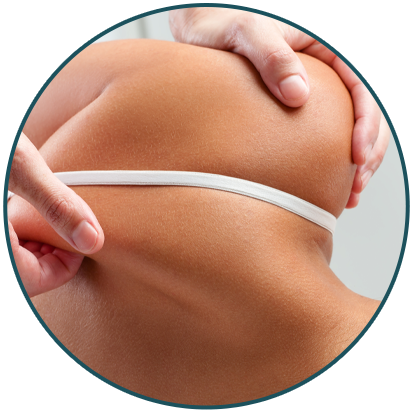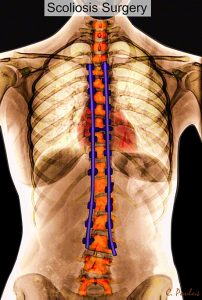Adult Scoliosis
Get the Care You Need
2-3% of the Population Have Scoliosis
About 6 million people in the United States have scoliosis. This statistic includes adults and children. Adult scoliosis can occur due to degenerative diseases or adolescent idiopathic scoliosis that was not caught. Though it depends on the cause and severity of the scoliosis, most cases of adult scoliosis do not need surgery. However, visiting a scoliosis doctor in Houston is recommended. They can not only diagnose the root cause of the scoliosis but can prescribe treatment that can enhance your quality of life.
Schedule a virtual spinal consultation with Dr. Ra’Kerry Rahman to begin your treatment.

Symptoms of Scoliosis
-
Uneven shoulders or hips
-
Prominent rib cage
-
Torso tilt
-
Prominent rib cage and/or shoulder blade
-
Legs of uneven length
-
Lower back pain
-
Shooting pain in legs
-
Also see Scoliosis and Kyphosis
Adult Scoliosis
Scoliosis is a spinal deformity wherein the spine curves sideways (laterally). Many people associate scoliosis with children, as it often occurs during adolescence. However, scoliosis can also affect adults. Sometimes an adult patient will discover that he or she had Adolescent Idiopathic Scoliosis (AIS) that was never diagnosed or treated, and that the symptoms only become obvious in later adulthood. In other instances, a patient may be diagnosed with Adult Degenerative Scoliosis.
Adult Degenerative Scoliosis has no roots in a childhood spinal deformity. It is sometimes called “de novo” or “new” scoliosis. It may be caused by one of several degenerative conditions often associated with aging, including spinal stenosis, degenerative disc disease, osteoporosis, or a vertebral compression fracture. When scoliosis is a result of the wear and tear of aging, it can affect the spine at any point, even up into the neck.

SYMPTOMS OF ADULT SCOLIOSIS
Several signs of scoliosis in an adult are the same as those in an adolescent. Patients with scoliosis might notice that one shoulder appears to be higher than another. They might have an uneven waist and notice that their hips are not in line. One side of the body may show a prominence in the rib cage, and one shoulder blade may be more prominent than another. Scoliosis can make the torso tilt to one side and can even result in the legs seeming to be of unequal lengths.
Since scoliosis is a sideways curve, it is not usually obvious when viewing a patient’s profile. However, adults with scoliosis may lean forwards in order to try to stretch out the back, especially if a nerve in the spine is being pinched.
Patients with Adult Degenerative Scoliosis often experience back pain. The pain is usually located in the lower back (ie the lumbar region). In some cases, adults with scoliosis may also notice shooting pain in their legs.
While adult degenerative scoliosis may cause modest problems in many patients, in very rare cases it can become so severe that it hinders lung and heart function, especially if the rib cage is pushed into an abnormal position close to the heart or lungs.
DIAGNOSIS OF ADULT DEGENERATIVE SCOLIOSIS
The first step towards an accurate diagnosis of scoliosis is for the patient to give his or her doctor a complete medical history regarding his or her spine. The doctor will ask questions about any episodes of back pain the patient has experienced, and if the pain has restricted movement. The doctor will also ask about treatments that have already been tried. While most cases of scoliosis do not seem to be hereditary, the doctors will still gather information about prior family history of scoliosis or other back problems.
The second part of the diagnostic process is a physical examination. The doctor will observe the patient doing range-of-motion and forward bending tests, which involve bending from waist in various directions. Reflexes and balance will also be tested, and leg length will be measured.
X-rays will most likely be ordered. A standing x-ray from the front and back will reveal if the spine curves once, making a c-curve, or twice, making an s-curve. If the doctor suspects that the degeneration of the spine has pinched a nerve or caused neurological damage, a myelogram may also be ordered to help identify any pinching of nerves.
TREATMENT OPTIONS FOR DEGENERATIVE SCOLIOSIS
For many scoliosis patients, no treatment will be required. If the curve is small, twenty degrees or less, the doctor will probably monitor the curve over the next year or two to ensure it is not progressing. If back pain is present, the doctor may prescribe a pain reliever and recommend an exercise plan to strengthen the back and promote good posture. Soft tissue therapy and massage can help to bring relief.
Sometimes a back brace is recommended. This will not cure scoliosis or correct the curve, but by adding back support it can help to reduce and manage pain. However, a back brace may also lead to the weakening of abdominal muscles, so it should only be used if suggested by a doctor.

A spine that has been instrumented with rods and screws to reduce a scoliosis curve
Surgical options will be explored in the most severe cases, typically when the curve exceeds 40 degrees. If the scoliosis is causing neurologic or cardiopulmonary problems or is causing disabling pain, or it is hindering a patient from carrying on their daily activities, surgery may be a suitable option.
If surgery is recommended, the surgeon will consider many factors about the individual patient’s case. The type of surgery recommended will be based on such factors as the location and size of the curve, the amount of spinal degeneration and pain, and if the function of the lungs and heart are being hindered.
During surgery, the aim will be to reduce the abnormal curves and to stabilize and re-balance the spine. If nerves are being pinched, steps will be taken to create more space around the nerves. During the surgery, the surgeons may implant specially designed rods and screws into the spine to help reduce the curve and stabilize the spine.
Spine surgery is a major step for any patient. Be assured that Dr. Rahman and his team will help you consider all possible treatment options. If surgery is selected, you can trust that Dr. Rahman has received exceptional training and has extensive experience performing surgery for adults with scoliosis.
